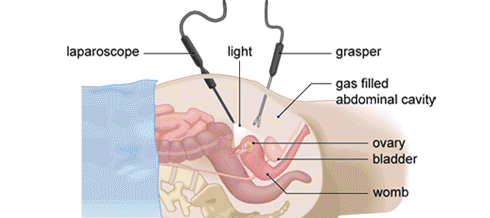A gynaecological laparoscopy is a procedure that allows a surgeon to look inside your pelvis, for example at your fallopian tubes, ovaries and uterus (womb). It can be used either to diagnose a condition or for treatment.

Gynaecological laparoscopy can be used to:
- diagnose and treat endometriosis
- remove adhesions (scar tissue)
- treat an ectopic pregnancy
- carry out female sterilisation (surgery on your fallopian tubes to prevent future pregnancy)
- remove an ovarian cyst
- remove your womb (hysterectomy) or ovaries (oophorectomy)
- treat fibroids
- investigate cancer or remove lymph nodes for cancer treatment
Your surgeon may take a biopsy during your procedure. A biopsy is a small sample of tissue. This can be sent to a laboratory for testing to determine the types of cell and if these are benign (not cancerous) or cancerous. Sometimes biopsies are also carried out to diagnose conditions such as endometriosis.
Your surgeon may also suggest a laparoscopy if you have pain in your abdomen because it may help to find out the cause. If you’re having problems getting pregnant, you can have a laparoscopy to see if there are any problems with your ovaries, fallopian tubes or womb.
What are the alternatives to a gynaecological laparoscopy?
Gynaecological laparoscopy isn’t suitable for everyone. Depending on your symptoms and circumstances there may be other investigations or treatments available.
An ultrasound or MRI scan can also be used to diagnose some gynaecological conditions such as fibroids. An ultrasound investigation uses sound waves to produce an image of the inside of part of your body. Most commonly, a trans-vaginal ultrasound is used, which involves an ultrasound probe being put into your vagina. An MRI scan uses magnets and radio waves to produce images of the inside of your body.
Your surgeon will recommend the best treatment option for you.
Procedure
A gynaecological laparoscopy is usually done under general anaesthetic.
Laparoscopy is a type of ‘key-hole surgery’. It uses a piece of equipment called a laparoscope. A laparoscope is a small telescope with an attached camera, which your surgeon will use to see inside your abdomen (tummy). It’s put through a small cut in your belly button. The procedure can take between 30 minutes and three hours, depending on what type of examination or treatment you need.
Your surgeon will make a cut in your belly button. They will then put a tube through the cut and pump some gas in, which expands your abdomen and separates your organs. This makes it easier for your surgeon to look at your organs with the laparoscope and to perform surgery if you need it.
Your surgeon may need to move some of your organs to get a good view. He or she may make one or more small cuts lower down on your abdomen. Any surgical instruments (such as a grasper) that are needed for your treatment can be inserted through these cuts. At the end of the procedure, your surgeon will carefully take the instruments out of your abdomen and allow the gas to escape, then close the cuts with stitches, clips or glue.
